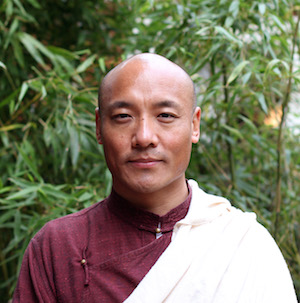Effortless Mindfulness (EM), also known as nondual mindfulness, is an ancient wisdom practice that integrates with contemporary neuroscience and psychology. It is an advanced, yet simple, next stage of mindfulness. EM allows you to shift out of your small chattering mind and into an already awake compassionate mind – any time of the day.
Watch Video Intro
Frequently Asked Questions
Effortless Mindfulness, also known as nondual mindfulness, is an advanced yet simple form of mindfulness that can be done with eyes open. It is a way of shifting your consciousness and opening to a profoundly calm and loving awareness that is already within and around you. “Effortless” does not mean that this mindfulness practice requires no effort. A short, initial effort is made, and then you discover an already existing awareness that is effortlessly compassionate and intuitively wise.
Many people have already experienced effortless mindfulness without knowing it. When people enter a “flow state” or feel “in the zone,” they’re often effortlessly mindful. If you’ve played a sport or a musical instrument or walked in nature and felt fully engaged, at ease without second-guessing yourself, and interconnected with everything around you, you were probably in a flow state.
The practice of Effortless Mindfulness allows you to access that joyful flow anytime, anywhere, regardless of your activity or environment. It is a natural capacity within each of us that we can learn to consciously embody and live from.
In the forms of mindfulness currently popular in the West (deliberate mindfulness), you often focus on your breath, body sensations, or passing thoughts. You witness the contents of your consciousness. In effortless mindfulness, you directly experience the context of your consciousness: you are aware of awareness.
What this means is that you no longer identify as the mini-me in your head, witnessing yourself and the world from a subjective distance. Instead, you experience yourself as an expansive, pervasive awareness—simultaneously transcending your small, separate self while also dwelling intimately within your own body. It’s as though you’re a wave in the ocean, and you know yourself as both ocean and wave.
Knowing yourself in this way allows you to feel a deep interconnection with others along with an embodied, natural wisdom. The experience of effortless mindfulness really must be felt to be understood. And fortunately, it is both teachable and learnable!
Learn more about the distinctions between nondual mindfulness and other forms of mindfulness with this article and video.
Not at all. You don’t need any meditation experience to practice Effortless Mindfulness. At the same time, advanced meditators may find that they awaken to new levels of awareness through this type of nondual mindfulness.
You also don’t need to follow any particular belief system or practice within any spiritual tradition. The optimal mind that is experienced in Effortless Mindfulness is equally available to us all because it is inherent to our humanness.
Yes, I have found many people who struggle with sitting meditation or concentration meditation, such as following the breath, are able to practice effortless mindfulness without any problem. Effortless Mindfulness can be done with your eyes open, and glimpse meditations seldom take more than a few minutes.
Effortless Mindfulness is also a practice that translates easily into life activities, such as walking, driving, working, and talking to others. Ultimately the hope is to live from open-hearted awareness rather than reserve this form of awareness for meditative interludes.
Here is a short glimpse practice you can try to get a feel for it.
Glimpse practices, which are like micro-meditations, are one of the best ways to initially practice and experience effortless mindfulness. Glimpses allow you to experience a shift in consciousness where you know yourself and your connection to the world differently, accessing a deeper truth and an inner peace.
You can find guided glimpses on the Guided Meditations: Glimpses page and also in my books and audio trainings.
I recommend spending at least 10 – 20 minutes per day with glimpse meditations. Then try to incorporate those you become familiar with into your day—while washing dishes, talking to a friend, or taking a walk. The most effective form of practice is small glimpses, many times over the course of a day.
With practice, you’ll find you can shift your awareness to a more peaceful and loving place in the midst of any activity at any time. And over time you’ll find you more naturally live from this expansive, compassionate, and wise consciousness as your default operating system.
I have seen many people with depression or anxiety helped by effortless mindfulness. I developed a form of psychotherapy called Nondual Mindfulness-Based Therapy (NMBT), which offers a path toward the relief of psychological pain.
NMBT is an empowering approach because it shows us that our emotions, thoughts, and behaviors are not the sum of who we are. We each have a true Self at our core that is capable of embracing, loving, and healing every part of ourselves—even the parts we’re ashamed of. Our true Self can bear anything that we typically find unbearable. Through the practice of Effortless Mindfulness, we can access our Self and learn to heal all types of emotional suffering, including shame, depression, and anxiety.
I have personally been diagnosed with attention deficit disorder, and I can testify, as can many of my students with ADHD, that Effortless <indfulness practice can dramatically improve focus.
I believe that what we call “attention deficit” should be renamed “attention overload.” Human attention is limited in its capacity to maintain directed focus. When we try to focus on a singular point from our conceptual minds, the system inevitably becomes distracted and overloaded.
With Effortless Mindfulness, you learn to step back from your thinking mind and into a spacious awareness where you can focus from a panoramic view. From this expansive viewpoint your way of knowing is no longer bound by the contents of your consciousness. The strain of trying to stay on track dissipates as you discover you are aware not from a single vantage point but from all vantage points simultaneously.
I have seen many people find relief from chronic pain through the practice of Effortless Mindfulness. Of course, it’s important to have a medical professional evaluate your condition and recommend treatment options. But some types of chronic pain persist even after medical treatment. In those instances, there are specific practices that can reduce or eliminate pain by training your awareness to change its relationship to pain.
Typically, pain is a signal from our nervous system that a threat is present. But if we’re in no immediate, actual danger, we can shift our awareness to a vantage point from which pain is no longer experienced as a threat. This shift in awareness quiets down our neurological alarm system, and any pain still present can become no more than background noise.
Absolutely. I deeply value all forms of mindfulness meditation. I have seen the mindfulness practice most commonly taught in the West—which I call deliberate mindfulness—help countless people cultivate calm, patience, and intentional lovingkindness.
The practice of Effortless Mindfulness can be learned after or independently of deliberate mindfulness. There is no incompatibility. In fact, some of my students like to begin their day with deliberate mindfulness meditation followed by nondual mindfulness glimpse practices.
It’s not uncommon for people to question if they’re doing glimpse practices “right.” If this question occurs to you, it is your “small” thinking mind interjecting its doubt into the process. And, actually, the thinking mind is right because it itself is not capable of intellectually understanding glimpses of awakening.
Glimpses occur when you’ve shifted out of the thinking mind and into a different form of awareness. This is a felt experience, and you will usually experience a sense of relief, a lightening of your mental load or emotional pain, a feeling of completeness, or some other sort of psychic shift.
Each person experiences effortless mindfulness in his or her own way, and each experience may be different than the previous experience. There are many facets to effortless mindfulness. I usually advise students who experience doubt to recognize that their ego center is offering its second opinion—which it loves to do—and then try to step back from thinking. Simply allow yourself to be open and curious and try different types of glimpses to see which ones work best for you.
Awakening is a term shared by many spiritual traditions, and it generally refers to experiencing a deep understanding that our limited perspective is only a small part of a vaster reality. This understanding is accompanied by changes in the way we live our lives, as we move away from the strongly self-protective viewpoint of our ego centers towards a loving sense of interconnection with one another.
I see awakening as a shift and upgrade of awareness, mind, and self. We move to an optimal way of knowing, being, and relating. Awakening is available to all, even those of us who feel we’re not “good” enough or ready yet. Optimal awareness already exists within each of us. I call this awareness “awake awareness” because it does not need to be developed or made to “awaken”; it is already awake and exists as the ground of our being. So the process of awakening is essentially learning how to access awake awareness and then live from its expansive and loving interconnectedness.
Read more about awakening in my article, Awakening: Discover Your Natural Potential.
Awake awareness is our foundation of knowing and the primary dimension of who we are. In different traditions it has been called “unity consciousness,” “true nature,” and “heart-mind.” It is our primary level of knowing—prior to thinking, including thinking, and beyond thinking.
Awake awareness is not a transcendent or meditative state but rather the ground of being. When you experience awake awareness, it does not feel like “I” am aware of something. Instead your experience is from a dimension of consciousness which is already awake by itself and aware without your help. It is what makes our consciousness conscious.
Awake awareness is not on most of our Western psychological maps, but it is recognized in some Eastern traditions. A defining characteristic of awake awareness is its nonduality. Nondual awareness is the experience of being aware both outside and inside your body simultaneously. It is not an either/or but a both. We typically are focused either on something in the external world or on self-referential thoughts. Research has shown that nondual awareness enables an atypical state of mind in which extrinsic and intrinsic experiences are increasingly synergistic rather than competing. We experience a balance and unity between inner and outer, without the need for ego-oriented, self-protective opinions, judgments, or the desire to control.
Learn more about awake awareness in my article, “Introducing Awake Awareness”.
Open-hearted awareness is one mode of expression of awake awareness. (See the previous FAQ answer for a definition of awake awareness.) It is an embodied way of knowing and being that feels lovingly connected to everyone and everything.
In different traditions it has been called “heart-mind,” bodhicitta, and the “mystic heart.” It is not the emotional heart or the heart chakra, but more of an embodied unconditional love and innate wisdom which naturally reaches out to connect to others, while feeling safe and supported in the ground of being.
When we live from open-hearted awareness, we are free of our small, mental sense of self that makes us fearful and feel unworthy. We are unconditionally self-accepting and can bear painful emotions that used to feel unbearable. We know on a profound level that all is essentially well.
Open-hearted awareness is not an experience, state, emotion, or belief; it is the essence of who we are. With the practice of Effortless Mindfulness, we can access and live from this essential goodness and compassion at our core.
Nonduality, also called nondualism, encompasses two simultaneous levels of reality: the relative and the absolute. Relative reality is our sensory experience of ourselves and the world as discrete entities and processes: me, you, that chair, the ocean, the sound of a dog barking, etc. Absolute reality is the underlying foundation of all these perceptually discrete entities and is invisible to our senses: for example, the molecules, atoms, and quarks that exist as mostly empty space. In absolute reality there are no distinctions.
Nonduality does not mean oneness. In Sanskrit it is called adavaita, which means “not two.” The two levels of reality are inseparable, but they’re not reduced to one. They exist simultaneously, which can be difficult to wrap our linear minds around. Awakening involves nondual awareness, in which we are aware of distinctions and unity simultaneously. For example, you apprehend the differences between me and you while also experiencing the sameness that unites us. From this awareness, compassion for ourselves and others naturally springs.
Effortless Mindfulness is a synthesis of ancient wisdom traditions, contemporary psychology, and current neuroscience.
It has its roots in world wisdom traditions that have been called direct path, essence traditions, or non-dual traditions. The primary tradition of effortless mindfulness draws from is called Sutra Mahamudra, which began in North India and links the three main Buddhist traditions: Theravada, Mahayana, and Tibetan. Sutra Mahamudra emphasizes the possibility of awakening in midst of everyday life.
I traveled for two years on a fellowship to study contemplative practices with teachers in Sri Lanka, India, and Nepal. I was particularly influenced by Tulku Urgyen Rinpoche. When I returned, I studied contemporary theories in psychology and practiced as a licensed psychotherapist for many years. I have continued contemplative practice and study with teachers like Tsoknyi Rinpoche, Mingyur Rinpoche, and Adyashanti.
Effortless Mindfulness is also informed by neuroscientific research. I’ve collaborated with neuroscientists from around the country, studying and gaining insight into how the brain functions during effortless mindfulness. I also founded and now direct the Effortless Mindfulness Research Center.
Is my membership fee tax-deductible?
Yes. There are no goods or services provided so your monthly membership fee is tax deductible to the full extent of the law. Each month you will receive an email with the amount and details for your records.
How is membership different from EM Mobile?
EM Mobile is our web-based platform that provides access to numerous teachings in exchange for a subscription fee, which helps us cover the cost of providing this service. Membership in Natural Wakefulness Center and its educational wing, Effortless Mindfulness Institute, is a tax-deductible donation that supports our 501(c)(3) non-profit’s work offering scholarships, building new content, delivering our podcast, offering retreats, providing teacher training programs, and fostering community engagement.
How do I participate in annual member meetings?
Members will receive email notice of any members meetings and the details for joining those meetings.
How do I cancel my membership?
If you would like to cancel your membership, please email us at [email protected].
What if I have other questions?
If you have additional questions please reach out to us at [email protected].
Multimedia Courses

Explore various courses offered by Loch Kelly in different formats. It’s designed to help you learn at your own pace covering different levels of learning.
Books by Loch Kelly

About Nondual
Mindfulness

Praise for Loch's Work















